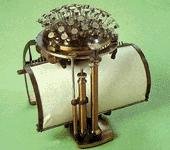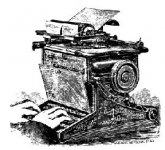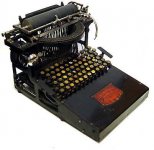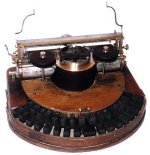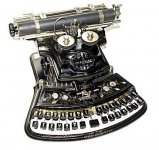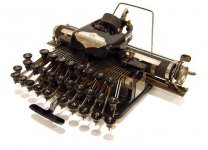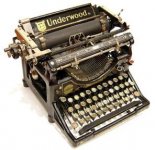-
Please be sure to read the rules and adhere to them. Some banned members have complained that they are not spammers. But they spammed us. Some even tried to redirect our members to other forums. Duh. Be smart. Read the rules and adhere to them and we will all get along just fine. Cheers. :beer: Link to the rules: https://www.forumsforums.com/threads/forum-rules-info.2974/
You are using an out of date browser. It may not display this or other websites correctly.
You should upgrade or use an alternative browser.
You should upgrade or use an alternative browser.
Going back to work after 30 years
- Thread starter lilnixon
- Start date
First off... That is dang funny Jan...

Second... I used to use a typewriter almost daily to type Bill's of Lading. It was electronic though and would "return" automatically...
Third... she should be shoving the typewriter with the right hand, off the left side of the desk, no?


Second... I used to use a typewriter almost daily to type Bill's of Lading. It was electronic though and would "return" automatically...
Third... she should be shoving the typewriter with the right hand, off the left side of the desk, no?

Trakternut
Active member
Funny how one forgets which way the carriage get's shoved for "Return". I started tinkering on an old Royal manual, took typing classes on an IBM Selectric. Remember that ball with all the characters that could be changed by flipping that latch up, taking the ball out, putting another in, flipping the latch down and away you go!
Lots less complicated than trying to defrag your "fraggin" computer.
Lots less complicated than trying to defrag your "fraggin" computer.
Bah. Kids.she should be shoving the typewriter with the right hand, off the left side of the desk, no?

Me too. The typewriter my parents bought for me in high school was a used manual, a real junker that didn't type evenly. I soon took my paper route money and bought an electric.had typing classes in first year high school, and they were all manuals.
Mom (b. 1910) wanted a PC real bad. I got her a simple XT clone. (Late 1980's, text and cursor keys only, no mouse.) Just like that vid, Mom soon gave up with the excuse that she couldn't use it without a carriage return lever. I kept repeating that the line would wrap when it got long enough but she couldn't grasp that concept.
P
Pigtails
Guest
I got to wondering what the old time typewriters looked like and found this:
The concept of a typewriter dates back at least to 1714, when Englishman Henry Mill filed a vaguely-worded patent for "an artificial machine or method for the impressing or transcribing of letters singly or progressively one after another." But the first typewriter proven to have worked was built by the Italian Pellegrino Turri in 1808 for his blind friend Countess Carolina Fantoni da Fivizzono (as established by Michael Adler in his excellent 1973 book The Writing Machine); unfortunately, we do not know what the machine looked like, but we do have specimens of letters written by the Countess on it.
Numerous inventors in Europe and the U.S. worked on typewriters in the 19th century, but successful commercial production began only with the "writing ball" of Danish pastor Malling Hansen (1870). This well-engineered device looked rather like a pincushion. Nietzsche's mother and sister once gave him one for Christmas. He hated it.
The concept of a typewriter dates back at least to 1714, when Englishman Henry Mill filed a vaguely-worded patent for "an artificial machine or method for the impressing or transcribing of letters singly or progressively one after another." But the first typewriter proven to have worked was built by the Italian Pellegrino Turri in 1808 for his blind friend Countess Carolina Fantoni da Fivizzono (as established by Michael Adler in his excellent 1973 book The Writing Machine); unfortunately, we do not know what the machine looked like, but we do have specimens of letters written by the Countess on it.
Numerous inventors in Europe and the U.S. worked on typewriters in the 19th century, but successful commercial production began only with the "writing ball" of Danish pastor Malling Hansen (1870). This well-engineered device looked rather like a pincushion. Nietzsche's mother and sister once gave him one for Christmas. He hated it.
Attachments
P
Pigtails
Guest
P
Pigtails
Guest
AND:
Christopher L. Sholes, a Milwaukee newspaperman, poet, and part-time inventor, was the main creator of this machine. The Sholes & Glidden typed only in capital letters, and it introduced the QWERTY keyboard, which is very much with us today. The keyboard was probably designed to separate frequently-used pairs of typebars so that the typebars would not clash and get stuck at the printing point. The S&G was a decorative machine, boasting painted flowers and decals. It looked rather like a sewing machine, as it was manufactured by the sewing machine department of the Remington arms company. For an in-depth look at this historic device, visit Darryl Rehr's Web site "The First Typewriter."
The Sholes & Glidden had limited success, but its successor, the Remington, soon became a dominant presence in the industry.
The Sholes & Glidden, like many early typewriters, is an understroke or "blind" writer: the typebars are arranged in a circular basket under the platen (the printing surface) and type on the bottom of the platen. This means that the typist (confusingly called a "typewriter" herself in the early days) has to lift up the carriage to see her work. Another example of an understroke typebar machine is the Caligraph of 1880, the second typewriter to appear on the American market.
Christopher L. Sholes, a Milwaukee newspaperman, poet, and part-time inventor, was the main creator of this machine. The Sholes & Glidden typed only in capital letters, and it introduced the QWERTY keyboard, which is very much with us today. The keyboard was probably designed to separate frequently-used pairs of typebars so that the typebars would not clash and get stuck at the printing point. The S&G was a decorative machine, boasting painted flowers and decals. It looked rather like a sewing machine, as it was manufactured by the sewing machine department of the Remington arms company. For an in-depth look at this historic device, visit Darryl Rehr's Web site "The First Typewriter."
The Sholes & Glidden had limited success, but its successor, the Remington, soon became a dominant presence in the industry.
The Sholes & Glidden, like many early typewriters, is an understroke or "blind" writer: the typebars are arranged in a circular basket under the platen (the printing surface) and type on the bottom of the platen. This means that the typist (confusingly called a "typewriter" herself in the early days) has to lift up the carriage to see her work. Another example of an understroke typebar machine is the Caligraph of 1880, the second typewriter to appear on the American market.
Attachments
P
Pigtails
Guest
Other machines typing from a single type element rather than typebars included the gorgeous Crandall (1881) ... and the practical Blickensderfer.
The effort to create a visible rather than "blind" machine led to many ingenious ways of getting the typebars to the platen. Examples of early visible writers include the Williams and the Oliver. The Daugherty Visible of 1891 was the first frontstroke typewriter to go into production: the typebars rest below the platen and hit the front of it. With the Underwood of 1895, this style of typewriter began to gain ascendancy. By the 1920s, virtually all typewriters were "look-alikes": frontstroke, QWERTY, typebar machines printing through a ribbon, using one shift key and four banks of keys. The most popular model of early Underwoods, the #5, is still to be found everywhere.
Let's return for a moment to the 19th century. The standard price for a typewriter was $100 -- comparable to the price of a good personal computer today. There were many efforts to produce cheaper typewriters. Most of these were index machines: the typist first points at a letter on some sort of index, then performs another motion to print the letter. Obviously, these were not heavy-duty office machines; they were meant for people of limited means who needed to do some occasional typing. An example is the "American" index typewriter, which sold for $5. Index typewriters survived into the 20th century as children's toys; one commonly found example is the "Dial" typewriter made by Marx Toys in the 1920s and 30s.
The effort to create a visible rather than "blind" machine led to many ingenious ways of getting the typebars to the platen. Examples of early visible writers include the Williams and the Oliver. The Daugherty Visible of 1891 was the first frontstroke typewriter to go into production: the typebars rest below the platen and hit the front of it. With the Underwood of 1895, this style of typewriter began to gain ascendancy. By the 1920s, virtually all typewriters were "look-alikes": frontstroke, QWERTY, typebar machines printing through a ribbon, using one shift key and four banks of keys. The most popular model of early Underwoods, the #5, is still to be found everywhere.
Let's return for a moment to the 19th century. The standard price for a typewriter was $100 -- comparable to the price of a good personal computer today. There were many efforts to produce cheaper typewriters. Most of these were index machines: the typist first points at a letter on some sort of index, then performs another motion to print the letter. Obviously, these were not heavy-duty office machines; they were meant for people of limited means who needed to do some occasional typing. An example is the "American" index typewriter, which sold for $5. Index typewriters survived into the 20th century as children's toys; one commonly found example is the "Dial" typewriter made by Marx Toys in the 1920s and 30s.

